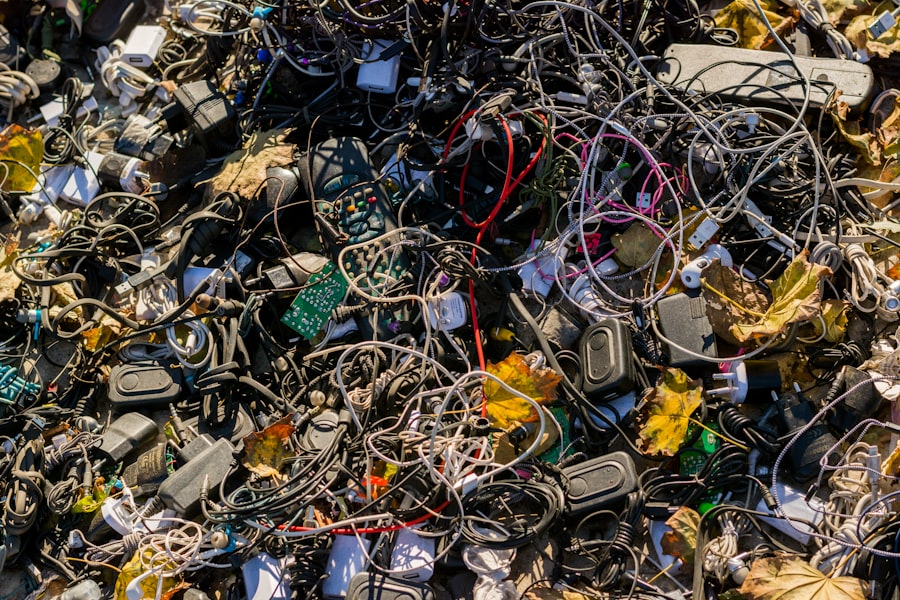The rapid advancement of technology has led to an unprecedented increase in electronic waste, commonly referred to as e-waste. This term encompasses discarded electrical and electronic devices, including everything from smartphones and laptops to refrigerators and televisions. According to the Global E-Waste Monitor 2020, an estimated 53.6 million metric tons of e-waste were generated worldwide in 2019, a figure projected to rise to 74 million metric tons by 2030.
This staggering growth is largely attributed to the short lifespan of electronic products, driven by consumer demand for the latest technology and the phenomenon of planned obsolescence, where products are designed with a limited useful life. The implications of this burgeoning e-waste crisis are profound, affecting not only the environment but also public health and economic stability. Many developing countries, which often serve as dumping grounds for e-waste from wealthier nations, face significant challenges in managing this toxic burden.
The improper disposal of e-waste can lead to the leaching of hazardous substances such as lead, mercury, and cadmium into soil and water systems, posing serious risks to both ecosystems and human health. As the global community grapples with this pressing issue, it becomes increasingly clear that innovative solutions and collaborative efforts are essential to mitigate the impacts of e-waste.
Key Takeaways
- The global e-waste problem is a growing concern with the rapid advancement of technology and increasing electronic consumption.
- E-waste has a significant impact on the environment and public health, with toxic chemicals leaching into soil and water, and informal recycling processes posing health risks to workers.
- Current challenges in e-waste management include inadequate recycling infrastructure, lack of awareness, and the high cost of proper disposal and recycling.
- Innovative tech solutions such as e-waste recycling and reuse technologies are emerging to address the growing e-waste problem.
- Artificial intelligence and robotics play a crucial role in e-waste sorting and processing, improving efficiency and accuracy in recycling operations.
The Impact of E-Waste on the Environment and Public Health
The environmental consequences of e-waste are alarming. When electronic devices are improperly disposed of, they can release a cocktail of toxic substances into the environment. For instance, lead from circuit boards can contaminate soil and groundwater, while brominated flame retardants used in plastics can accumulate in the food chain, posing risks to wildlife and humans alike.
The incineration of e-waste is another significant concern; it not only releases harmful pollutants into the air but also contributes to climate change through the emission of greenhouse gases. Public health is equally at risk due to the hazardous materials found in e-waste. Workers in informal recycling sectors, often in developing countries, are particularly vulnerable.
They may be exposed to toxic substances without adequate protective measures, leading to serious health issues such as respiratory problems, skin diseases, and neurological disorders. Children living near e-waste dumping sites are also at risk, as they may come into contact with contaminated soil or water. The World Health Organization has recognized e-waste as a significant public health challenge, emphasizing the need for urgent action to protect vulnerable populations.
Current Challenges in E-Waste Management

Despite growing awareness of the e-waste crisis, effective management remains fraught with challenges. One major issue is the lack of comprehensive regulations governing e-waste disposal and recycling.
In regions where regulations do exist, enforcement can be weak, allowing informal recycling operations to flourish without oversight. This often results in unsafe working conditions and environmental degradation. Another challenge is the complexity of electronic devices themselves.
Modern electronics are often designed with a multitude of materials that can be difficult to separate during recycling processes. For example, smartphones contain a mix of metals, plastics, and glass that require specialized techniques for recovery. Additionally, many manufacturers do not provide clear information on how to recycle their products or offer take-back programs, leaving consumers unsure about how to dispose of their old devices responsibly.
This lack of transparency contributes to the growing volume of e-waste that ends up in landfills or is incinerated.
Innovative Tech Solutions for E-Waste Recycling and Reuse
In response to the escalating e-waste crisis, innovative technological solutions are emerging that aim to enhance recycling processes and promote reuse. One such solution is the development of advanced recycling technologies that can efficiently recover valuable materials from electronic devices. For instance, hydrometallurgical processes use chemical solutions to extract metals like gold and copper from circuit boards with minimal environmental impact compared to traditional methods.
These technologies not only improve recovery rates but also reduce the carbon footprint associated with mining virgin materials. Another promising approach is the design of modular electronics that facilitate easier repair and upgrading. Companies like Fairphone have pioneered this concept by creating smartphones that can be easily disassembled and repaired by users.
This not only extends the lifespan of devices but also reduces the amount of e-waste generated. Additionally, initiatives promoting refurbishment programs allow consumers to return their old devices for refurbishment and resale, further contributing to a circular economy where products are reused rather than discarded.
The Role of Artificial Intelligence and Robotics in E-Waste Sorting and Processing
Artificial intelligence (AI) and robotics are playing an increasingly vital role in improving e-waste sorting and processing efficiency. Traditional manual sorting methods are often labor-intensive and prone to errors, leading to lower recovery rates of valuable materials. However, AI-powered systems can analyze large volumes of e-waste quickly and accurately, identifying different materials and components for optimal recycling pathways.
Robotic systems equipped with machine learning algorithms can be trained to recognize various electronic components and separate them accordingly. For example, companies like ZenRobotics have developed robotic sorting systems that utilize AI to identify and sort different types of waste materials in real-time. These advancements not only enhance the efficiency of recycling operations but also reduce labor costs and improve safety by minimizing human exposure to hazardous materials.
Advancements in Sustainable Materials and Design for Electronics

The push for sustainability in electronics manufacturing has led to significant advancements in materials science and design practices. Manufacturers are increasingly exploring alternative materials that are less harmful to the environment and easier to recycle. For instance, bioplastics derived from renewable resources are being developed as substitutes for traditional petroleum-based plastics used in electronic devices.
These materials can reduce reliance on fossil fuels and lower the overall environmental impact of electronics production. Moreover, eco-design principles are gaining traction among manufacturers who aim to create products with a reduced environmental footprint throughout their lifecycle. This includes designing for disassembly, where products are constructed in a way that allows for easy separation of components at the end of their life cycle.
Companies like Apple have committed to using recycled materials in their products and have set ambitious goals for reducing their carbon emissions through sustainable design practices.
The Potential of Blockchain and IoT in E-Waste Tracking and Management
Blockchain technology and the Internet of Things (IoT) offer transformative potential for tracking and managing e-waste throughout its lifecycle. Blockchain provides a decentralized ledger that can record every transaction related to an electronic device, from its manufacture to its eventual disposal or recycling. This transparency can help ensure compliance with regulations and promote responsible practices among manufacturers and consumers alike.
IoT devices can enhance this tracking capability by providing real-time data on the location and condition of electronic products. For example, smart sensors embedded in devices could monitor their usage patterns and alert users when it’s time for maintenance or replacement. This proactive approach not only extends the lifespan of electronics but also facilitates better planning for recycling initiatives by providing insights into when devices are likely to be discarded.
Collaborative Efforts and Policies for a Circular Economy in E-Waste Management
Addressing the global e-waste problem requires collaborative efforts among governments, businesses, non-profit organizations, and consumers. Policymakers play a crucial role in establishing regulations that promote responsible e-waste management practices while incentivizing manufacturers to adopt sustainable design principles. Extended producer responsibility (EPR) policies are gaining traction worldwide, requiring manufacturers to take responsibility for their products throughout their lifecycle, including end-of-life disposal.
Initiatives that encourage recycling programs at local levels can empower communities to participate actively in reducing e-waste generation. Collaborative partnerships between businesses and non-profits can also drive innovation in recycling technologies and create job opportunities within the green economy.
As stakeholders work together towards a circular economy model for electronics, it becomes increasingly possible to mitigate the impacts of e-waste on both the environment and public health while fostering sustainable economic growth.
A related article to How Tech is Solving the Global E-Waste Problem is “Best Software for 3D Animation” which discusses the latest advancements in software technology that are revolutionizing the field of animation. This article highlights how innovative software tools are enabling animators to create stunning visuals and immersive experiences. To learn more about the best software for 3D animation, check out the article here.
FAQs
What is e-waste?
E-waste refers to electronic waste, which includes discarded electronic devices such as computers, mobile phones, and other electronic equipment.
Why is e-waste a global problem?
E-waste is a global problem because of the increasing amount of electronic devices being discarded, which leads to environmental pollution and health hazards due to improper disposal and recycling methods.
How is technology helping to solve the global e-waste problem?
Technology is helping to solve the global e-waste problem through innovations such as e-waste recycling technologies, sustainable product design, and the development of circular economy models for electronic devices.
What are some examples of tech solutions for e-waste management?
Examples of tech solutions for e-waste management include automated e-waste sorting systems, advanced recycling processes for recovering valuable materials from electronic devices, and the use of blockchain technology for tracking e-waste throughout the recycling process.
How can individuals contribute to solving the e-waste problem through technology?
Individuals can contribute to solving the e-waste problem through technology by responsibly recycling their electronic devices, supporting companies that prioritize sustainable product design and recycling practices, and advocating for e-waste management policies and regulations.

